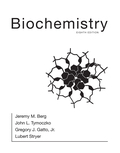
Interpretation:
The balanced reaction for the conversion of pyruvate to alpha-ketoglutarate along with the cofactors and enzymes involved in it should be determined.
Concept introduction:
Answer to Problem 23P
The balanced reaction for the conversion of pyruvate to alpha-ketoglutaratealong with the cofactors and enzymes involved in itis given below:
Explanation of Solution
The balanced reaction for the conversion of pyruvate to alpha-ketoglutaratealong with the cofactors and enzymes involved in itis given below:
The citric acid cycle is a catabolic process. It is a series of
Following are the cofactors and enzymes involvedin the conversion of pyruvate to alpha-ketoglutarate are:
1.Pyruvate dehydrogenase enzyme complex: It is required for the linking of glycolysis and TCA. It helps in the conversion of pyruvate into Acetyl CoA. Acetyl CoA then enters into the series of the citric acid cycle.
The balanced reaction for the conversion of pyruvate to alpha-ketoglutaratealong with the cofactors and enzymes involved in itis given below:
Want to see more full solutions like this?
Chapter 17 Solutions
EBK BIOCHEMISTRY
- Understanding the Oxidation of Glucose and Its Products in the TCA Cycle Glycolysis, the pyruvate dehydrogenase reaction, and the TCA cycle result in complete oxidation of a molecule of glucose to CO2. Review the calculation of oxidation numbers for individual atoms in any molecule, and then calculate the oxidation numbers of the carbons of glucose, pyruvate, the acetyl carbons of acetyl-CoA. and the metabolites of the TCA cycle to convince yourself that complete oxidation of glucose involves removal of 24 electrons and that each acetyl-CoA through the TCA cycle gives up 8 electrons.arrow_forwardUnderstanding the Mechanism of the 3-ketosphinganine Synthase Reaction Write a reasonable mechanism for the 3-ketosphinganine synthase reaction, remembering that it is a pyridoxal phosphate-dependent reaction.arrow_forwardThe Effect of lodoacetic Acid on the Glyceraldehyde-3-P Dehydrogenase Reaction (Integrates with Chapters 4 and 14.) How might iodoacetic acid affect the glyceraldehydes-3-phosphate dehydrogenase reaction in glycolysis? Justify your answer.arrow_forward
- Introduction: As one of the reactants in the first reaction of the citric acid cycle, oxaloacetate is an important cellular metabolite. The concentrations of oxaloacetate are tightly regulated. Different organisms employ different mechanisms to obtain oxaloacetate. In mammals and yeast, oxaloacetate is the product of the pyruvate carboxylase (PYC) reaction. In E. coli, the enzyme phophoenolpyruvate carboxylase (PPC) provides oxaloacetate from phosphoenolpyruvate (PEP) obtained from glucose oxidation in the glycolytic pathway. If glucose is absent and E. coli is using acetate as a carbon source, the glyoxylate pathway serves to generate the needed oxaloacetate. Usually, an organism will employ PPC or PYC, but not both. Detectable levels of PYC in the methanogenic bacterium Methanobacterium thermautotrophicum had previously not been found, and since PPC had been detected, it was believed that M. thermautotrophicum did not possess PYC. However, in the case described here, microbiologists…arrow_forwardSuppose a liver extract capable of carrying out normal metabolic reactions (including gluconeogenesis) is incubated with pyruvate partially labeled with deuterium at the methyl group (see below: D= deuterium, i.e., H-2) a) Explain why the oxaloacetate formed in step 1 of gluconeogenesis is only partially labeled (i.e., some of the oxaloacetate is labeled and some is not). b) Where would the label be found in glucose?arrow_forwardMalonate (p. 227) poisons the citric acid cycle because it inhibits succinate dehydrogenase. After reviewing its structure, describe how the inhibitory effect of malonate can be overcome.arrow_forward
 BiochemistryBiochemistryISBN:9781305577206Author:Reginald H. Garrett, Charles M. GrishamPublisher:Cengage Learning
BiochemistryBiochemistryISBN:9781305577206Author:Reginald H. Garrett, Charles M. GrishamPublisher:Cengage Learning
